Dog Tracks
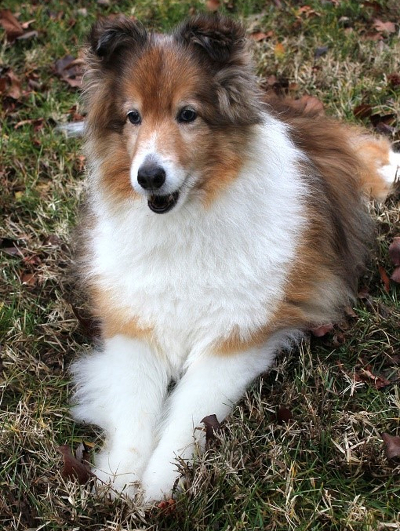
By Chris Byrd
The ability to differentiate domestic dog tracks from the tracks of other mammals (such as coyotes, wolves, foxes, and cougars) is a helpful skill for many purposes, especially anyone using tracking for mammal surveys.
Canine Foot Morphology:
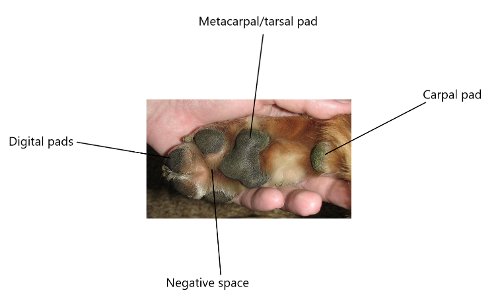 Dog foot
Dog footFunction of the Pads:
The pads and other structures of the feet are composed of keratin, collagen and adipose tissue (fatty tissue). The digital, and metacarpal/tarsal pads serve as shock absorbers for the bones of the feet and legs, and provide insulation during cold weather. The cone shape of the carpal pad provides traction and balance along with the first toe on the front foot and the claws of the digital pads.
The tissue that composes the foot pads of dogs will thicken and roughen due to friction on hard surfaces much as a human foot will develop a callus under similar conditions. Very old dogs may begin to show a degeneration of the pads (creases, indentations). In older dogs (as well as other animals) individual toes may begin to drift out of alignment with the other toes.
Canine Track Morphology:
Front foot tracks of all canines:
Canines have 4 fully developed toes that register on front foot tracks. An additional smaller toe (referred to as "toe 1") is reduced and occurs higher up on the front leg and only registers in tracks occasionally when at higher speeds, in deeper substrates, or during during abrupt stops/turns.
Claws usually register with most canine species.
Front tracks are usually longer than wide.
The negative space is in the shape of an ‘x’ or an ‘h’ and the metacarpal pad is usually triangular and singular, not divided into sub-pads.
A single carpal pad sits posterior to the metacarpal pad on the lateral side of the leg.
The total area of the digital pads is greater than the area taken up by the metacarpal/metatarsal area.
The tracks of canines when split bilaterally lengthwise will show more symmetry than feline tracks (see example feline track below).
Cougar track for comparison:
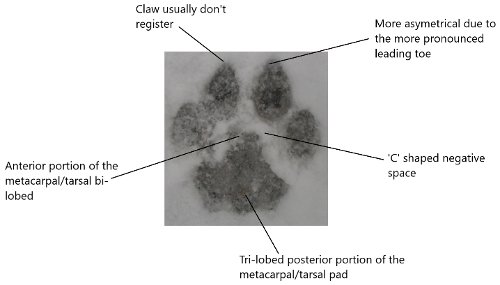 Cougar track for comparison
Cougar track for comparisonHind foot tracks of canines:
Hind tracks are similar to the front tracks but differ in being narrower and having less registration of the metatarsal pad due to the steeper angle of the ankle joint on the hind foot.
Domestic Dog Tracks:
Front Foot Track:
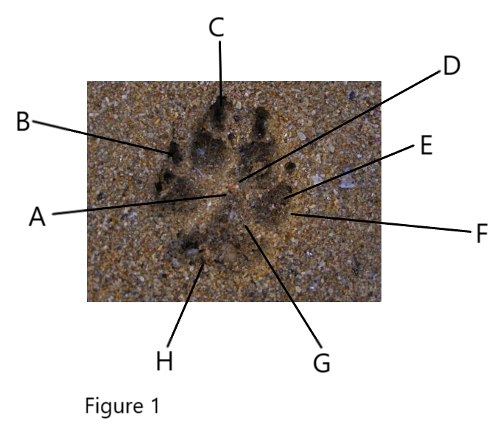 Domestic dog front foot track
Domestic dog front foot trackKey to Figure 1:
A) The negative space tends to be horizontally elongated; sometimes referred to as star-shaped.
B) The claws on the outer toes tend to be prominent and divergent from the middle portion of the track.
C) Claws are usually blunt.
(some domestic dogs may not show any claws due to being de-clawed).
D) The middle toes extend below a line drawn across the tops of the outer toes.
E) Toes are large and blocky (usually larger than the tip of your index finger). The outer toes are often smaller than the larger inner toes. The outer toes often cup the middle toes on the inside of the digital pad.
F) Tracks are often splayed due to the animal being overweight.
G) Metacarpal pad triangular in overall outline with a “pinched” area near the anterior portion of the pad.
H) Metacarpal pad tends to be flat and wide with the metacarpal pad registering on the same plane as the digital pads.
Note: The vast majority of domestic dogs have tracks that will measure under 100 MM in length. Only the largest breeds such as great danes, saint bernards and irish wolf hounds will meet or exceed that length.
Hind Foot Track:
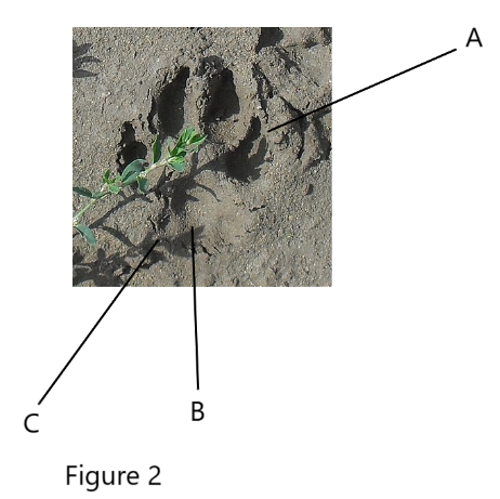 Domestic dog hind foot track
Domestic dog hind foot trackKey to Figure 2:
A) Overall the track is narrower than the front track.
B) The metatarsal pad registers lighter than the metacarpal pad and consists of an elongated oval.
C) On the lower sides of the primary oval are two smaller wing-like sub-pads.
Three Primary Foot Morphologies of Domestic Dog Tracks:
1) Cat-footed:
Many breeds of domestic dog have tracks classed as cat-footed. Cat-footed breeds have tracks that have an overall rounded shape reminiscent of cats. Cat-footedness is an adaptation for weight bearing and is found in many large working breed dogs.
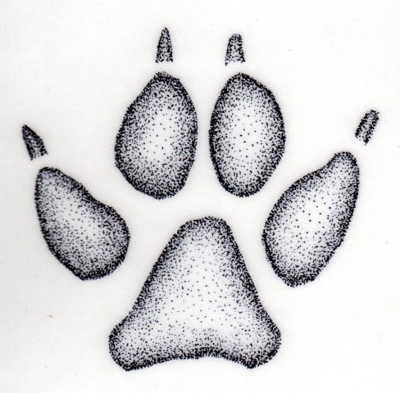 Domestic dog track that has cat-footed shape
Domestic dog track that has cat-footed shape2) Canine-footed:
Canine footed breeds have feet that more closely resemble the feet of wild canines such as coyotes.
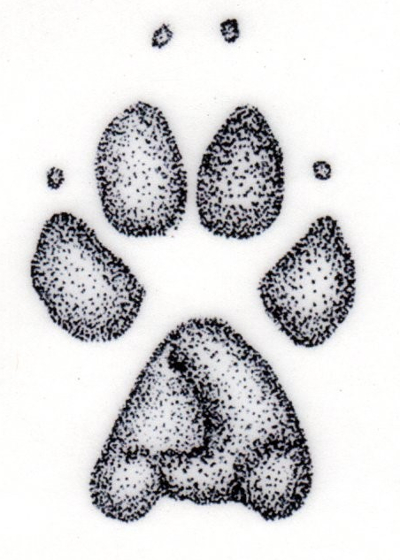 Domestic dog track that has canine-footed shape
Domestic dog track that has canine-footed shape3) Hare-footed:
Hare footed dogs have elongated central toes that allow for quick acceleration much like the feet of lagomorphs (rabbits and hares). Breeds that exhibit hare-footedness are terriers, borzoi’s, and greyhounds.
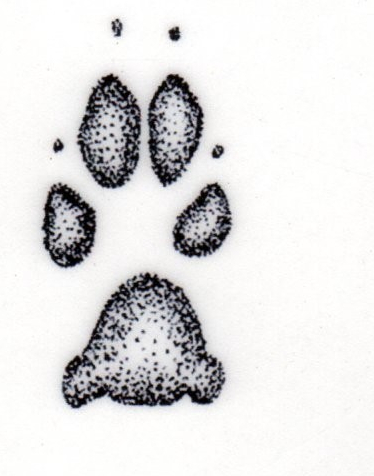 Domestic dog track that has hare-footed shape
Domestic dog track that has hare-footed shapeAdditional Note: Webbed Feet - Certain breeds such as Labrador retrievers exhibit mesial webbing between the digital pads that aid in swimming. Many hunting breed dogs also exhibit this trait.
Be More Prepared For Your Next Outdoor Adventure!

Don't leave without knowing these six essential survival skills. Our free survival mini guide reveals the strategies of:
- Shelter & fire to prevent the number one cause of death
- Obtaining clean water to avoid life-threatening dehydration
- Common wild survival foods and other critical skills!

Distinguishing Domestic Dog Tracks from
other Canids and Felids
Domestic Dog Tracks vs Wolf Tracks
The tracks of large dog breeds and wolves can be difficult to distinguish. Most large domestic dogs are cat-footed and the tracks tend to splay more than the tracks of wolves. The outer toes in wolves will splay in deep substrate, at higher speeds, or in large males. The middle two toes will stay tight in wolves, while often slightly splaying in domestic dogs.
Overall, the tracks of wolves tend to be more digitigrade (toe heavy) with deeper digital pad registration than metacarpal/tarsal pads. Domestic dogs tend to have tracks that are flatter (the metacarpal/tarsal registering nearly as deep as the digital pads).
As mentioned earlier, the middle toes (called toes 3 & 4) sit on a higher plane than the outer toes (called toes 2 & 5), giving the digital pads of the track a 2-ranked appearance in wolves.
The track patterns of domestic dogs also tend to be sloppy and inefficient with their use of energy (lots of direction and speed changes), while the trails of wolves tend to be more efficient and purposeful (straighter lines and more consistency in gaits).
Note: In wolves, younger age classes may have tracks between 75-100 MM in length.
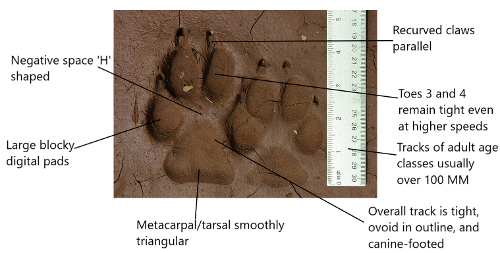 Differentiating characteristics of wolf tracks
Differentiating characteristics of wolf tracks
Domestic Dog Tracks vs Coyote Tracks
Many of the same identification features discussed in the wolf/dog vignette will also aid in the identification process of domestic dog tracks versus coyote tracks.
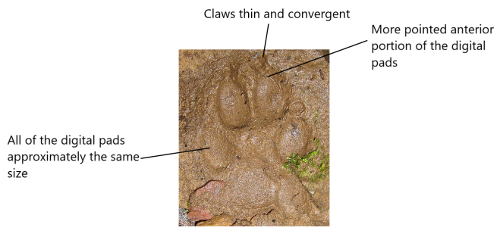 Differentiating characteristics of coyote tracks
Differentiating characteristics of coyote tracks
Domestic Dog Tracks vs Red Fox Tracks
The toes of red foxes are more wedge-shaped than the toes of domestic dogs and other canids. Red foxes have fur-covered pads which helps differentiate them from small and medium-sized domestic canines.
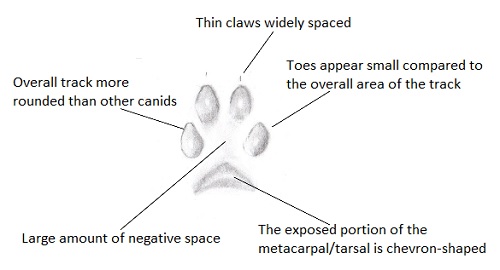 Differentiating characteristics of red fox tracks
Differentiating characteristics of red fox tracks
Domestic Dog Tracks vs Lynx Tracks
The tracks of Canadian lynx differ from domestic dogs in having a ‘bean’ shaped metacarpal/tarsal pad instead of the triangular pad of the dog. The digital pads of the lynx rarely show claws and the negative space is large and wide, as compared to the smaller ‘x’ to ‘h’ shaped negative space seen in dogs. Lynx also show significant spacing of the digital pads due to abundant fur on the feet.
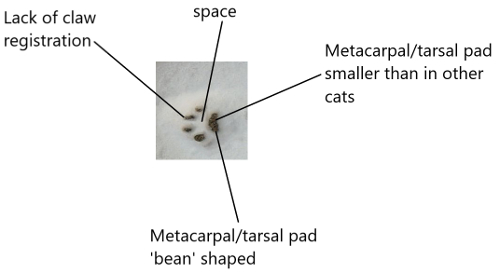 Differentiating characteristics of lynx tracks
Differentiating characteristics of lynx tracks
Domestic Dog Tracks vs Domestic Cat Tracks
The tracks of domestic cats can resemble those of small domestic dogs. Domestic cats have the characteristic tri-lobed posterior metacarpal/tarsal pad as well as the bi-lobation of the anterior portion of the pad (sometimes the metatarsal pad of the hind foot will only show a single lobe).
Domestic cats have large digital pads in comparison to the area of the metacarpal/tarsal resembling the ratio seen in canines. Domestic cats, especially as they age, are prone to a loosening of the claw attachment tendons which leads to a higher proportion of tracks with claw registration.
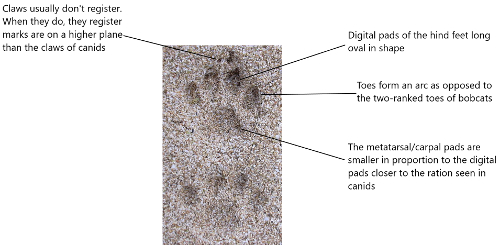 Differentiating characteristics of domestic cat tracks
Differentiating characteristics of domestic cat tracks
Although knowing how to identify the tracks of domestic canines may lack the mystery and charisma associated with tracking wild canines, the skill holds still holds a valuable place in the tool-kit of those devoted to non-invasive wildlife studies.
The skills gained through the study of domestic dog tracks apply to a variety of situations both in town and in the backcountry, and your studies can begin right outside your backdoor!
By the way, when you're out tracking or looking for wild animals, it's important to know how to stay safe in the outdoors, especially if you were to get lost. Right now you can get a free copy of our mini survival guide here, where you'll discover six key strategies for outdoor emergencies, plus often-overlooked survival tips.
Additional Resources:
Canine versus Feline Tracks on the Beartracker website
Wildlife Tracking Courses at Alderleaf

About the Author: Chris Byrd is an instructor at Alderleaf. He has been teaching naturalist skills for over twenty years. Learn more about Chris Byrd.
Return from the Dog Tracks Article back to Wildlife Tracking Articles
Is The Essential Wilderness Survival Skills Course Right for You? Take the "Online Survival Training Readiness" Quiz
See for yourself if this eye-opening course is a good fit for you. It takes just a few minutes! Get your Survival Training Readiness Score Now!

Grow Your Outdoor Skills! Get monthly updates on new wilderness skills, upcoming courses, and special opportunities. Join the free Alderleaf eNews and as a welcome gift you'll get a copy of our Mini Survival Guide.

 The Six Keys to Survival: Get a free copy of our survival mini-guide and monthly tips!
The Six Keys to Survival: Get a free copy of our survival mini-guide and monthly tips!
Learn more